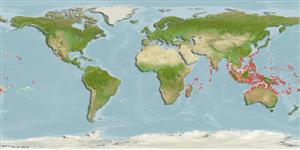Common names from other countries
Teleostei (teleosts) >
Gobiiformes (Gobies) >
Gobiidae (Gobies) > Gobiinae
Etymology: Priolepis: Greek, prio = to saw + Greek,lepis = scale (Ref. 45335); inhaca: Named for its type locality, Inhaca Island, Mozambique (Ref. 10753).
More on author: Smith.
Environment: milieu / climate zone / depth range / distribution range
Ecology
Marine; reef-associated; non-migratory; depth range 12 - 26 m (Ref. 1602). Tropical; 30°N - 27°S
Indo-Pacific: East Africa to Taiwan and the Society Islands.
Size / Weight / Age
Maturity: Lm ? range ? - ? cm
Max length : 4.0 cm TL male/unsexed; (Ref. 2798)
Short description
Identification keys | Morphology | Morphometrics
Dorsal spines (total): 7; Dorsal soft rays (total): 9 - 10; Anal spines: 1; Anal soft rays: 8. This species has a few, relatively narrow (less than pupil diameter) light bars on the head (Ref. 37816); characterized by pinkish grey with dark brown scale edges forming a network; presence of three pale vertical lines below eye and interconnected pale lines on top of head; absence of pelvic frenum; longitudinal scale series 26-28; predorsal scales 12-17; ctenoid body scales; cycloid scales on pectoral fin base, breast and midlaterally on abdomen; opercle of adult with cycloid scales; predorsal scales absent; posterior edge of tubular posterior nostril adherent to edge of orbit; cheek with single vertical row of papillae; depth of body 4.0 in SL (Ref. 90102).
Has been collected from lagoons and drop-offs (Ref. 1602). Also found in reef crevices (Ref. 90102).
Life cycle and mating behavior
Maturities | Reproduction | Spawnings | Egg(s) | Fecundities | Larvae
Hoese, D.F., 1986. Gobiidae. p. 774-807. In M.M. Smith and P.C. Heemstra (eds.) Smiths' sea fishes. Springer-Verlag, Berlin. (Ref. 2798)
IUCN Red List Status (Ref. 130435)
CITES (Ref. 128078)
Not Evaluated
Threat to humans
Harmless
Human uses
Tools
Special reports
Download XML
Internet sources
Estimates based on models
Preferred temperature (Ref.
115969): 25.2 - 28.9, mean 27.7 (based on 214 cells).
Phylogenetic diversity index (Ref.
82804): PD
50 = 0.5000 [Uniqueness, from 0.5 = low to 2.0 = high].
Bayesian length-weight: a=0.01023 (0.00477 - 0.02194), b=3.02 (2.84 - 3.20), in cm Total Length, based on LWR estimates for this (Sub)family-body shape (Ref.
93245).
Trophic level (Ref.
69278): 3.1 ±0.3 se; based on size and trophs of closest relatives
Resilience (Ref.
120179): High, minimum population doubling time less than 15 months (Preliminary K or Fecundity.).
Fishing Vulnerability (Ref.
59153): Low vulnerability (10 of 100).
